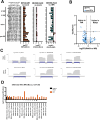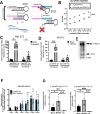Gammaherpesvirus infection triggers the formation of tRNA fragments from premature tRNAs
- PMID: 40444975
- PMCID: PMC12239594
- DOI: 10.1128/mbio.00875-25
Gammaherpesvirus infection triggers the formation of tRNA fragments from premature tRNAs
Abstract
Transfer RNAs (tRNAs) are fundamental for both cellular and viral gene expression during viral infection. In addition, mounting evidence supports the biological function for tRNA cleavage products, including the control of gene expression during conditions of stress and infection. We previously reported that infection with the model murine gammaherpesvirus 68, MHV68, leads to enhanced tRNA transcription. However, whether this has any influence on tRNA transcript processing, viral replication, or the host response is not known. Here, we combined two new approaches, sequencing library preparation by ordered two template relay (OTTR) and tRNA bioinformatic analysis by tRAX, to quantitatively profile full-length tRNAs and tRNA fragment (tRF) identities during MHV68 infection. We find that MHV68 infection triggers both pre-tRNA and mature tRNA cleavage, resulting in the accumulation of specific tRFs. OTTR-tRAX revealed not only host tRNAome changes, but also the expression patterns of virally encoded tRNAs (virtRNAs) and virtRFs made from the MHV68 genome. Because the transcript ends of several host tRFs matched tRNA splice junctions, we tested and confirmed the role of tRNA splicing factors TSEN2 and CLP1 in MHV68-induced tRF biogenesis. Further, we show that CLP1 kinase, which regulates tRNA splicing among other RNA processing events, is required for efficient MHV68 replication. Our findings provide new insight into how gammaherpesvirus infection both impacts and relies on tRNA transcription and processing.IMPORTANCEDiverse conditions of infection and cellular stress incite the cleavage of transfer RNAs (tRNAs), leading to the formation of tRNA fragments (tRFs) that can directly regulate gene expression. In our study of gammaherpesviruses, such as murine herpesvirus 68 and human oncogenic Kaposi sarcoma-associated herpesvirus, we discovered that tRNA regulation and cleavage are key components of gene reprogramming during infection. We present the first in-depth profile of tRF generation in response to DNA virus infection, using state-of-the-art sequencing techniques that overcome several challenges with tRNA sequencing. We present several lines of evidence that tRFs are made from newly transcribed premature tRNAs and propose that this may be a defining characteristic of tRNA cleavage during infection. Finally, we show that tRNA splicing machinery is involved with the formation of some MHV68-induced tRFs, with a key regulator of splicing, CLP1, required for maximal viral titer. Taken together, we posit that tRNA processing may be integral to the elegant shift in gene expression that occurs during viral takeover of the host cell.
Keywords: herpesviruses; tRNA; tRNA fragments; tRNA splicing; viral tRNA; virology.
Conflict of interest statement
H.E.U. and K.C. are named inventors on patent applications filed by the University of California describing OTTR-associated technology and have equity in Karnateq, Inc., which licensed the technology and has produced kits for OTTR cDNA library preparation.
Figures








Update of
-
Gammaherpesvirus infection triggers the formation of tRNA fragments from premature tRNAs.bioRxiv [Preprint]. 2024 May 2:2024.05.01.592122. doi: 10.1101/2024.05.01.592122. bioRxiv. 2024. Update in: mBio. 2025 Jul 9;16(7):e0087525. doi: 10.1128/mbio.00875-25. PMID: 38746336 Free PMC article. Updated. Preprint.
Similar articles
-
Gammaherpesvirus infection triggers the formation of tRNA fragments from premature tRNAs.bioRxiv [Preprint]. 2024 May 2:2024.05.01.592122. doi: 10.1101/2024.05.01.592122. bioRxiv. 2024. Update in: mBio. 2025 Jul 9;16(7):e0087525. doi: 10.1128/mbio.00875-25. PMID: 38746336 Free PMC article. Updated. Preprint.
-
Short-Term Memory Impairment.2024 Jun 8. In: StatPearls [Internet]. Treasure Island (FL): StatPearls Publishing; 2025 Jan–. 2024 Jun 8. In: StatPearls [Internet]. Treasure Island (FL): StatPearls Publishing; 2025 Jan–. PMID: 31424720 Free Books & Documents.
-
Glycoproteins gM and gN are indispensable factors for rhesus macaque rhadinovirus replication and spread but can be reconstituted by KSHV chimeras.J Virol. 2025 Mar 18;99(3):e0192224. doi: 10.1128/jvi.01922-24. Epub 2025 Feb 25. J Virol. 2025. PMID: 39998253 Free PMC article.
-
The Black Book of Psychotropic Dosing and Monitoring.Psychopharmacol Bull. 2024 Jul 8;54(3):8-59. Psychopharmacol Bull. 2024. PMID: 38993656 Free PMC article. Review.
-
Signs and symptoms to determine if a patient presenting in primary care or hospital outpatient settings has COVID-19.Cochrane Database Syst Rev. 2022 May 20;5(5):CD013665. doi: 10.1002/14651858.CD013665.pub3. Cochrane Database Syst Rev. 2022. PMID: 35593186 Free PMC article.
References
-
- Blanco S, Dietmann S, Flores JV, Hussain S, Kutter C, Humphreys P, Lukk M, Lombard P, Treps L, Popis M, Kellner S, Hölter SM, Garrett L, Wurst W, Becker L, Klopstock T, Fuchs H, Gailus-Durner V, Hrabĕ de Angelis M, Káradóttir RT, Helm M, Ule J, Gleeson JG, Odom DT, Frye M. 2014. Aberrant methylation of tRNAs links cellular stress to neuro-developmental disorders. EMBO J 33:2020–2039. doi: 10.15252/embj.201489282 - DOI - PMC - PubMed
MeSH terms
Substances
Grants and funding
LinkOut - more resources
Full Text Sources
